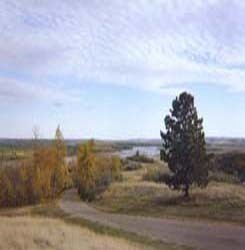
- Capital City:
- Jefferson City
- Nickname:
- Show Me State
- Motto:
- Salus Populi Suprema Lex Esto (The Welfare of the People Shall Be the Supreme Law)
- Statehood:
- August 10, 1821 (24th)
- Origin of State's Name:
- Named after Algonquin Indian term meaning "river of the big canoes."
- Largest Cities:
- Kansas City, Saint Louis, Springfield, Independence, Columbia
- Border States:
- Arkansas, Illinois, Iowa, Kansas, Kentucky, Nebraska, Oklahoma, Tennessee
- Land Area:
- 68,898 sq. mi., 18th largest
- State Bird:
- Bluebird
- State Flower:
- Hawthorn (crataegus)
- State Tree:
- American Dogwood (cornus florida)
- State Song:
- Missouri Waltz
Missouri is called the "Show Me State," because its people have a reputation for believing only what they see. Its name is an Algonquin Indian term meaning "river of the big canoes." Originally home to a number of Indian tribes, the state entered the Union in 1821. Today, more than half the population lives in Missouri's two major cities--Kansas City and St. Louis. The dogwood is the state tree, the bluebird is the state bird and the capital is Jefferson City.
Great Forest Park Balloon Race
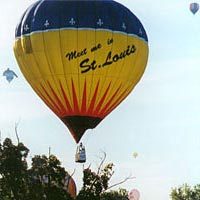
Held the third weekend in September each year in St. Louis' Forest Park, the Great Forest Park Balloon Race today hosts more than 67 balloons and 200,00 spectators. The Forest Park event is the largest and one of the most prestigious one-day balloon races in the world. The event free to spectators; corporate sponsorship, including St. Louis hometown company Energizer, pays pilot expenses. In 1994, the largest hot-air balloon manufactured in the United States, the ten-story high Energizer Bunny Hot Hare Balloon, made its debut at the race and, since that time, has become a real crowd favorite. Another crowd-pleaser, the St. Louis Symphony in 1992 began the tradition of a open-air performance before lift-off, a benefit event for the restoration of Forest Park, the "Glow in the Park."
Balloon racing has a long tradition in St. Louis; it was 1906 when the New York Herald Tribune sponsored an international long-distance balloon race, and St. Louis was selected as its first site. Balloons made prior to 1960 were carried aloft by helium, a lighter-than-air gas that provided buoyancy. Modern balloons, known as hot-air balloons, carry an on-board burner that heats ordinary air to provide buoyancy. In December 1973, pioneer woman pilot Nikki Caplan brought the first Forest Park hot-Air balloon race to St. Louis, with six balloons and 20 spectators, at an informal weekend gathering. The 25th anniversary in 1997 of the Great Forest Park Balloon Race was celebrated; a special poster depicting the Race was commissioned to commemorative the event.
Particularly prestigious and challenging, the race is by invitation only to pilots with greater than average requirements for flight hours and experience. Launch is from the middle of a major city, as opposed to being in open fields. One pilot noted: "When we got above the trees...[t]here were simply no open spots, just TV antennas, rooftops, trees and wires." Backyards, baseball diamonds, golf courses, lawns, street intersections, and, in one instance, the walled convent grounds of the School Sisters of Notre Dame, have been pressed into service as landing sites.
Max Hunter Collection
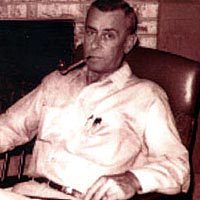
Max Hunter's legacy preserves the musical heritage of the Ozarks. With the advent of radio and TV, and its pervasive influence on the popular culture, the folk patterns of the Ozarks were endangered. People no longer had reason to sit on the porch and entertain themselves with story and song. Thanks to the diligent work of musical folklorist and former traveling salesman Max Hunter, a comprehensive annotated audio archive of Ozark folk music exists to preserve and disseminate these important recordings of our collective past. Hunter, a native of Springfield, Missouri, housed his collection of original recordings in the Springfield-Greene County Library. The entire body of work has been transcribed into a series of notebooks, also archived at the library. Hunter died in November 1999 at age 78 in Springfield.
In cooperation with Southwest Missouri State University Department of Music, in a continued effort to preserve and update the medium on which this priceless collection is stored, the work was transferred to digital audiotape and from there to compact disc in 1998. This project contains an archive of almost 1,600 Ozark Mountain folk songs, recorded between 1956 and 1972 by Max Hunter, on a collection of 40 2-disc CD sets. The permanent collection is housed at the Springfield-Greene County Library.
National Tom Sawyer Days
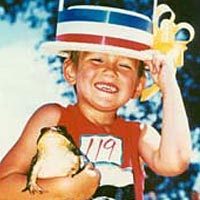
This celebration originated in 1956 in Hannibal, Missouri, Mark Twain's boyhood hometown, with a Tom Sawyer fence-painting contest, sponsored by the Hannibal Jaycees, and a "Tom and Becky" contest, sponsored by the Hannibal Chamber of Commerce. In 1959, the event was moved to the Fourth of July. According to the chartering resolution, "the celebration is dedicated to the recognition of that most lovable, yet unpredictable phenomenon of our American society, the small boy and his fascination for the big river as immortalized by Mark Twain."
Events include fence-painting and frog-jumping contests, and the selection of a new Tom and Becky to reign over the festival and represent the town at other events. A parade features contest entrants, floats, and bands. Designed and executed by the Hannibal Jaycees, a spectacular fireworks display draws visitors from a 100-mile radius. The festival is in its 44th year. Project materials include photos, slides and a report.
Sayers Bison Festival
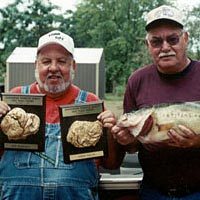
The Bison Fest was begun in 1994 as a fundraiser by the Sayersbrook Christian Foundation to raise college scholarship funds. The foundation was started in 1989 by Connie and Skip Sayers, who wanted to use part of their proceeds from selling Sayers Printing Company to fund college scholarships for Washington County students.
The Bison Festival, held at the Sayersbrook Bison Ranch, is a day is filled with fun, which involves bison herd tours, a bison barbecue and a gourmet bison dinner, an auction, a hummer rally, heritage craft demonstrations, pontoon boat rides, tank rides, music archery demonstrations, quilting demonstrations, anvil shoots.
The 1999 Bison Fest grossed more than $40,000 for scholarships. Between 1994 and 1999, the Sayers Christian Foundation has awarded more than 90 scholarships to Washington County youths. The scholarships are based on interviews, grades, extracurricular activities, and an essay on "how to improve the economy of Washington Country." Over the past six years, seventy-five percent of essays focused on the problem of welfare.
Local business donations and the annual Bison Fest Scholarship Day at Sayersbrook Bison Ranch are the fund's main support.
 Print
Print Email
Email







